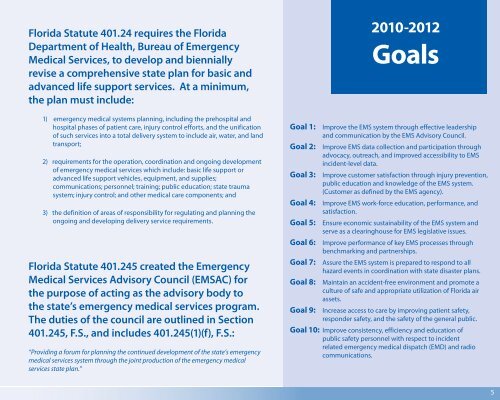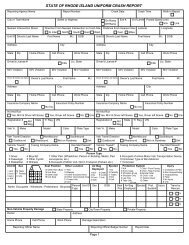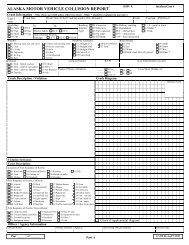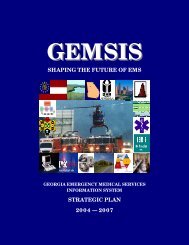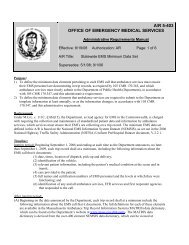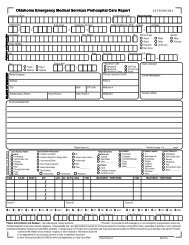Florida's Emergency Medical Services Strategic Plan
Florida's Emergency Medical Services Strategic Plan
Florida's Emergency Medical Services Strategic Plan
You also want an ePaper? Increase the reach of your titles
YUMPU automatically turns print PDFs into web optimized ePapers that Google loves.
Florida Statute 401.24 requires the FloridaDepartment of Health, Bureau of <strong>Emergency</strong><strong>Medical</strong> <strong>Services</strong>, to develop and bienniallyrevise a comprehensive state plan for basic andadvanced life support services. At a minimum,the plan must include:2010-2012Goals1) emergency medical systems planning, including the prehospital andhospital phases of patient care, injury control efforts, and the unificationof such services into a total delivery system to include air, water, and landtransport;2) requirements for the operation, coordination and ongoing developmentof emergency medical services which include: basic life support oradvanced life support vehicles, equipment, and supplies;communications; personnel; training; public education; state traumasystem; injury control; and other medical care components; and3) the definition of areas of responsibility for regulating and planning theongoing and developing delivery service requirements.Florida Statute 401.245 created the <strong>Emergency</strong><strong>Medical</strong> <strong>Services</strong> Advisory Council (EMSAC) forthe purpose of acting as the advisory body tothe state’s emergency medical services program.The duties of the council are outlined in Section401.245, F.S., and includes 401.245(1)(f), F.S.:“Providing a forum for planning the continued development of the state’s emergencymedical services system through the joint production of the emergency medicalservices state plan.”Goal 1: Improve the EMS system through effective leadershipand communication by the EMS Advisory Council.Goal 2: Improve EMS data collection and participation throughadvocacy, outreach, and improved accessibility to EMSincident-level data.Goal 3: Improve customer satisfaction through injury prevention,public education and knowledge of the EMS system.(Customer as defined by the EMS agency).Goal 4: Improve EMS work-force education, performance, andsatisfaction.Goal 5: Ensure economic sustainability of the EMS system andserve as a clearinghouse for EMS legislative issues.Goal 6: Improve performance of key EMS processes throughbenchmarking and partnerships.Goal 7: Assure the EMS system is prepared to respond to allhazard events in coordination with state disaster plans.Goal 8: Maintain an accident-free environment and promote aculture of safe and appropriate utilization of Florida airassets.Goal 9: Increase access to care by improving patient safety,responder safety, and the safety of the general public.Goal 10: Improve consistency, efficiency and education ofpublic safety personnel with respect to incidentrelated emergency medical dispatch (EMD) and radiocommunications.5


